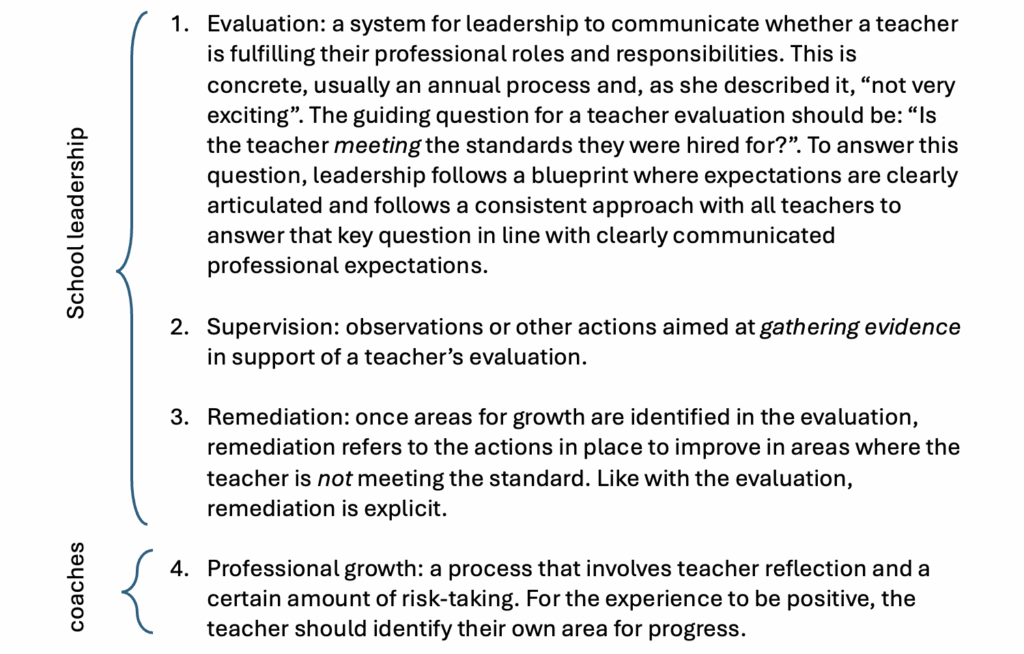This spring, I had the opportunity to attend a thought-provoking Pop-Up Conference hosted by Paul Magnuson at Leysin American School. I was able to link up for a morning conversation with Dr. Samantha Olson-Wyman on the evolving role of instructional coaching in professional development. Dr. Olson-Wyman emphasized a key principle: professional growth must be separated from evaluation. This idea is foundational to our Professional Learning Plan model at Institut Le Rosey, where Learning Partners—trained in facilitative and dialogical coaching—support teachers in identifying growth areas, preparing strategies, and reflecting on their experiences.
Dr. Olson-Wyman provided useful definitions for related terminology:

Once these 4 definitions are presented, it becomes clear why the process of evaluation (terms 1-3 above) should be separate from professional growth objectives (term 4), so that both endeavours can be successful: any teacher concerned about job security is unable to focus on professional growth. Secondly, for a successful process of risk-taking and reflection (leading to professional growth), teachers need the support from someone removed from managerial judgement (and criticism).
Institut Le Rosey has a successful Professional Learning Plan model precisely for this reason. Our Learning Partners (trained in facilitative and dialogical coaching) do not have supervisory responsibilities over the colleagues they support, and the sequence we follow begins with a teacher’s self-reflection and collecting evidence in areas of interest, then moving to identifying goal, strategy, schedule to embed the practice, and reflecting on the experience/ planning next steps. In their supervisory role, school leaders cannot act as coaches; however, Dr Olson-Wyman encourages leaders to “embrace a coaching stance” in their interactions with teachers, but to avoid overlapping purpose and responsibilities with coaches.
Designing a Robust Evaluation Model
Given that an effective professional growth model is in place, we should reflect on the key elements of a formal evaluation model. The first step is to define professional standards, potentially drawn from our Definition of High Quality Learning and Assessment Policy. Next, we should determine the components and sequence of the evaluation process—who, when, what, and how. Finally, we must outline the roles and responsibilities of evaluators and ensure alignment among school leaders.
Dr Olson-Wyman highlighted that, once the standards are defined, an evaluation process must include measuring teacher success against those standards—otherwise, there is no actual “evaluation” (keeping in mind that the evaluator seeks evidence that the teacher meets the standard). When necessary, the evaluation would lead to a concrete action plan for areas deemed “below standards”, as well as a clear method to monitor progress on that action plan. Naming additional support structures that facilitate success would be a final key area for consideration.
Of course, the biggest hurdle is implementation for long-term application. Some key questions might be:
- Who needs to articulate, approve, and agree to the standards for evaluation?
- Who is responsible for evaluating teachers? What qualifies them to do so?
- What is the length of the process, and how often does it happen?
- What resources are used to make the process clear and accessible to all?
- What additional factors should be considered if an action plan must be put in place?
- What is the connection between employment and evaluation? What is at stake?
I would be very interested to know how other schools designed and launched a teacher evaluation protocol at their schools. If you have any experiences to share, reach out on LinkedIn!
